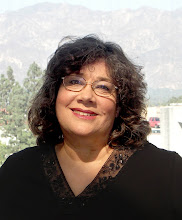
Petrea wins with her 12:04 p.m. Tuesday guess "Could it be the early bicycle way that was meant to go from the Raymond Hotel to downtown?"
In the photo above, a portion of the Dobbins Bikeway, also known as the Arroyo Seco Bikeway and the California Cycleway, crosses over Bellevue Street. (The Pasadena Grand Opera House was at Raymond Avenue and Bellevue Street.)
Horace Dobbins, chairman of the City Board of Supervisors (precursor to City Council) from 1900 to 1901, had the vision for a tollway that bicyclists could take from downtown Pasadena to downtown Los Angeles.
Here's his portrait in the Hall of Mayors:

In 1897 Dobbins formed the California Cycleway Company. The vice president was former California Governor H.H. Markham, a Pasadena resident, and together they championed the cause, took it to the California legislature twice, provided the start-up funding, supervised construction and were the cycleway's most ardent promoters.
Construction began in 1899. It was quite an ambitious undertaking and an engineering feat. The toll was 10¢ one-way or 15¢ round-trip.
The first mile and a quarter, from the Hotel Green to Raymond Hill, opened on Jan. 1, 1900.

Note the toll booth at the bottom of this photo:

Here are some passages from the November 1901 issue of Good Roads Magazine:
On this splendid track cyclists may now enjoy the very poetry of wheeling. At Pasadena they may mount their cycles and sail down to Los Angeles without so much as touching the pedals, even though the gradient is extremely slight. The way lies for the most part along the east bank of the Arroyo Seco, giving a fine view of this wooded stream, and skirting the foot of the neighboring oak-covered hills. The surface is perfectly free from all dust and mud, and nervous cyclists find the track safer than the widest roads, for there are no horses to avoid, no trains or trolley-cars, no stray dogs or wandering children...But eventually a practical invention -- the horseless carriage -- caused the demise of the bikeway.
...Throughout the entire distance from the center of one city to the center of the other it has an uninterrupted right of way, passing over roads, streets, railway tracks, gullies and ravines. At its highest point, the elevation of the track is about fifty feet...
...At present, the cycle-way is wide enough to allow four cyclists to ride abreast, but its width may be doubled presently...
...From the engineer's point of view, the road is a triumph. No fewer than 1,250,000 feet of best Oregon pine were used in its construction. The wood is painted dark green. At night, the cycle-way looks like a gleaming serpent, for it is brightly lit with incandescent lights on both sides.
Dobbins used the bikeway as a backdrop as he posed on his new-fangled wheels -- a decision he may have lived to regret!

The cycleway was dismantled due to disuse and all that lumber was sold (early recycling!). Later the Arroyo Seco Parkway (now the Pasadena Freeway) was constructed on the same route, and Dobbins became known as the grandfather of the scenic freeway.
Pasadena has been a bike-friendly city for well over 100 years. You can learn more about current City of Pasadena bicycle programs here.
Many thanks to Pasadena Public Library, Pasadena Museum of History and U.S. Department of Transportation/Federal Highway Administration for information and photographs included in this posting.

7 comments:
Hooray, Petrea. Love Mystery History!
Very cool! Congrats Petrea.
Congrats Petrea!
This is the saddest history lesson I've ever heard. I can't believe there was an elevated pathway that allowed bikers to ride from Pasadena to LA completely unbothered! Even sadder that it was dismantled because of lack of use.
When will we learn?
I never heard of such a thing. Wow.
What a fabulous thing--this was.
I'm collecting a whole set of City Hall tchochkes.
We need to get some other competitors in here. I feel guilty for winning twice.
But I accept. Thank you, Ann, this is a blast.
This is an interesting piece of history about early transportation.
Post a Comment